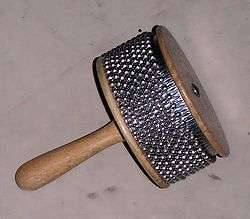Cabasa
|
A metal afuche-cabasa | |
| Percussion instrument | |
|---|---|
| Classification | Percussion |
| Hornbostel–Sachs classification |
112.1 (Shaken idiophones or rattles The player executes a shaking motion) |
| Inventor(s) | Martin Cohen |
| Developed | Modern version 1960s, based on a traditional instrument of the same name |
| Builders | |
| Latin Percussion, Meinl Percussion, many others | |
The cabasa, similar to the shekere, is a percussion instrument that is constructed with loops of steel ball chain wrapped around a wide cylinder. The cylinder is fixed to a long, narrow wooden or plastic handle.
The cabasa of gourd was originally of African origin. The African original version of the Cabasa is called, agbe, and is constructed from dried oval- or pear-shaped gourds with beads strung on the outer surface.[1] There are many versions of this instrument, particularly in Latin music. Cabaca (pictured), is used in Latin American Dance. The Cabaca is a natural or synthetic round or pear-shaped gourd covered with a network of beads and finishing in a single handle. This is compared to the metal version used in Latin Jazz music.[2]
The metal cabasa was created by Martin Cohen, founder of Latin Percussion. This company have built a more durable cabasa that they call an afuche-cabasa (pictured). It provides a metallic, rattling sound when shaken or twisted, similar to the sound of a rattlesnake. It is often used in Latin jazz, especially in bossa nova pieces. Precise rhythmic effects can be gained by the advanced player. The player places his non-dominant hand on the metal chain, to provide pressure, while holding the wooden handle with the other hand and twisting the instrument back and forth as per the rhythmic pattern desired. In addition to Latin music, many band and orchestra pieces call for the cabasa.
The instrument is frequently used in music therapy, particularly with individuals who have physical/neurological disabilities as it requires minimal hand movement to produce a sound. The sound produced by the individual can then be reinforced by the music therapist, which builds neurological connections between hand movement and hearing the sound, in turn encouraging more fluent hand movements.
Modern adaptions
Modern adaptions of this instrument include Meinl Percussion foot pedal.
Users
- Ed O'Brien (on "Paranoid Android", "Present Tense")
- Spencer Bohren
- Morgan Nicholls (on "Supermassive Black Hole")
- Evan Gattis
- [(Diane Rose]] [(Houston, TX)]
References
External links
| Wikimedia Commons has media related to Cabasa / Afuché. |
- https://www.youtube.com/watch?v=D9eRN1c3sug Strong cabasa track played by Paulinho da Costa / Lennie Castro, on the song Your Ways on the 1980 Triumph album by The Jackson 5
This article needs to be categorised in a subcategory of Category:Percussion instruments by means of sound production

